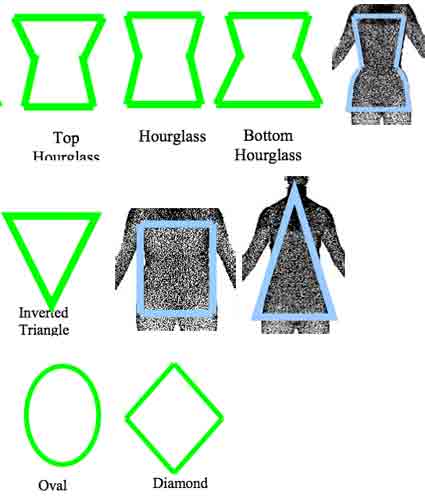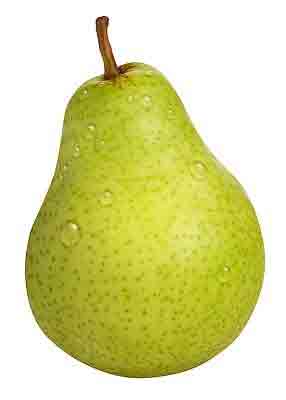Some fascinating research suggests we need 9 body shapes, not 4 or 5, to describe everyone effectively.
The research was done at North Carolina State University. Nancy Erickson briefly mentioned this source in her recent newsletter. I though I’d follow up, and found full reports on-line here.
(And hey, I’ve learned a little about new spreadsheet software. Happily the learning curve for this is only vertiginously steep the first time you do it ! And I’ve found how to jump around in a post. Lots of technical progress :D)
Three main sections in this post :
– the nine body shapes.
– difficulties with doing this sort of study.
– how many people have these shapes.
– – –
Nine Body Shapes
All the studies were made using full body scans.
The initial study found they needed nine body shapes to categorise everyone clearly. See research report pdfs one and two.
–
Top Hourglass (TH) :
Bust larger than hips.
Waist defined, and different from both.
Hourglass (H) :
Small difference between bust and hips.
Waist defined, and different from both bust and hips.
Bottom Hourglass (BH) :
Hips larger than bust.
Waist defined, and different from both.
Spoon (S) :
Hips larger than bust.
Waist different from high hip.
Bust tapers to waist, but waist doesn’t taper evenly to hips. High hips make a noticeable bump in the silhouette.
Inverted Triangle (IT) :
Bust larger than hips.
No clear waist.
Rectangle (R) :
Bust and hips are fairly equal.
No clear waistline.
Triangle (T) :
Hips larger than bust.
No clear waist.
Oval (O) :
Measures above (stomach), at, and below (abdomen) waist level are smaller than bust, larger than hips.
These people have a large mid-section.
Diamond (D) :
Mid-section larger than both bust and hips.
–
Sadly, they don’t say the actual numbers or ratios they used for deciding that bust or hips were ‘larger’, or that someone’s waist was noticeably smaller than their bust or hips. The shape decisions were made by software, so this must have been done by numbers not someone’s judgement.
– – –
Simple symbols for the shapes

(Oval shape has bust larger than midriff.)
Images from this report pdf.
– – –
Difficulties with doing this sort of study
Skip to the main results if you’re not interested in details and problems.
I’m going to mention two sets of results in this section :
– Test sample of over 500 younger people, used to check how well the software decides which shape is the best fit for each body scan. (this report pdf) (yellow in charts)
– Misses group of several thousand people with less complete measurements (this report pdf) (blue in charts).
As the purpose of that report was assessing current shape standards, and those standards don’t include stomach and abdomen measures, they were not included in the large study. So sadly the Oval and Diamond shapes weren’t identified. My guess is most Ovals were classified as Inverted Triangle, and Diamonds as Rectangle (see later post on details).
The research found three quarters of these people didn’t fit the official standard shape specification well ! – no surprise to people who try to buy RTW. . .
Table of the results I’m using is here as a pdf.
Chart of results from those two groups :

All charts show percentage of people in the group who have this body shape.
Yellow = Test sample group.
Blue = Misses group.
For example, 31 % of the test group were classified as Rectangle shape, 43 % of the Misses were.
The test group and the main group have different results. They look dramatically different, but at most the percentages differ by less than 13 %.
It’s obviously difficult to get precise counts of the numbers of people with different body shapes.
Results depend on the group of people measured, This needs to include all age ranges, as well as ethnic groups in the same proportions as in the main population. (All those Japanese pattern books with Extra Large = 38 inch hip show how different other countries can be !)
It also depends on the quality of the measurements. You’d think full body scan data would be as precise as you can get, but there are a couple of problems. The measures are affected by what the people being measured chose to wear. And by how correctly the software identifies the right point on the body to take the measurements. (Examples in this report pdf.)
And the results will obviously be affected by the specific numbers used to identify upper-equal-lower body emphasis, yes-no waist, yes-no high hip.
According to statistical theory, a larger group should give more reliable results. There were fewer measurements from the larger group, so two of the shapes were not included. Even so, I give those results more emphasis.
– – –
Main results
Despite all the difficulties, it is possible to make generalisations.
Here are the percent results for the Misses (blue) and Over 55s (red) groups from the main study pdf (6300 people). I’ve combined the 3 Hourglass shapes (I wouldn’t usually group them together, as Top Hourglass, Hourglass, and Bottom Hourglass have very different fit and flattery needs).

A lot of people are Rectangles (R), about 2 out of 5.
Many people are Spoons (S), at least 1 in 5.
Among younger people (blue), Inverted Triangles (IT) (upper body emphasis, no waist) and combined Hourglass shapes (H+TH+BH) (with waist, equal or upper or lower body emphasis) are about equally frequent (about 1 in 7).
Among the Over 55s (red), it looks as if many of those Hourglasses may have become Inverted Triangles (about 1 in 3).
Interesting. I thought people put on weight below the waist as we get older. But it looks as if many of us put on weight above the waist !
No wonder there is a such a large and vocal group wanting information about doing a Full Bust Adjustment 😀
Less than 1 in 20 are Top Hourglass, the classic film star shape.
Perhaps 1 in 45 are Triangle shape, which is usually considered the basic ‘pear’ shape.
There were no Oval and Diamond people in the Misses and Over 55s groups, because the measurements to identify them weren’t included in that study. But the results from the test sample suggest at least 1 in 8 people have a prominent midriff. It’s a pity this body feature wasn’t included in the main study, so these shapes get forgotten again, even though there are a lot of people like this !
Presumably the basic body shapes stay the same around the world. But these numbers for how many people have each shape are from the USA. The most frequent body shapes might be different in northern, southern or eastern Europe, Middle East, Africa, India, Asia, China, Japan. . .
What about more details ? The body shapes are based on relative upper-lower body proportions and waist, also high hip shelf and midriff. So it’s possible to say a bit about these. That’s the focus of my second post, which is here.
– – –
Obviously we need to include stomach, abdomen, and high hip measures in our assessment of fit and body shape, not just the basic three of bust-waist-hips. A dominant midriff isn’t mentioned in body shape standards, so RTW don’t design for it. (If you are midriff dominant, see Gale Grigg Hazen “Fantastic Fit for Every Body” to cheer you on :D)
And of course many other body features affect fit and flattery. The researchers acknowledge that, but including them would have made the whole scheme too complex to be workable.
Can you recognise yourself as any of these 9 shapes ? or are you a person who needs to consider more detail in finding what flatters your own body ? (see later)
Do these more detailed shape descriptions help any of your fit or styling decisions ?
I’m definitely a ‘Spoon’. It is helpful not to be mixed up with Bottom Hourglass and Triangle. I realise how much my high hips affect which styles are good on me. I’ll describe myself as a Spoon not a Pear in future. A Pear sounds more attractive, but a Spoon is a good description of the shape 😀
Do these shapes clarify anything for you 😀
= = =
P.S. Some other sources on shape and style
lin3arossa comments she prefers Imogen Lamport’s shapes at Inside-Out Style.
Hmm – how do they match up ? Possibly :
Imogen . . . . . . . . . . . . . . North Carolina
8 High hip hourglass . . . Spoon
A Pear . . . . . . . . . . . . . . . Triangle
H Rectangle . . . . . . . . . . Rectangle
I Boyish
0 Apple . . . . . . . . . . . . . . Diamond
V Inverted Triangle . . . . Inverted Triangle
. . . . . . . . . . . . . . . . . . . . . . Oval
. . . . . . . . . . . . . . . . . . . . . . Top Hourglass
X Low hip hourglass . . . . Hourglass
. . . . . . . . . . . . . . . . . . . . . . Bottom Hourglass
I’m a Spoon and find it difficult to think of myself as a High Hip Hourglass, as I have a small bust.
Imogen is especially good on suggesting styles which flatter each shape, see her Body Shapes section.
Which system you like may depend on which tells you most about the special features of your own shape. Trinny & Susannah Body Shape Bible has twelve shapes. In their system I’m a Bell. Helped me know how important being short-waisted is in styling. Also that there are no celebrities this shape, so it really is difficult to look good 😀
The beautiful book ‘The Triumph of Individual Style‘ uses 6 basic body shapes. Plus whole chapters on type of line, length proportions, other shape elements, scale, colour, and texture. Some of these topics are also in Nancy Nix-Rice’s newsletter.
P.P.S. Don’t worry about squeezing yourself into a specific body shape ‘label’. Every body shape system has to be a simplification of all the possibilities.
Relatively large/ medium/ small size of shoulders/ bust/ waist/ high hips/ abdomen/ hips/ thighs,
square/ average/ sloping shoulders,
flat/ average/ large butt,
short/ average/ long waisted,
short/ average/ long bodied,
tall/ average/ petite height,
thin/ average/ plus body size.
I think that makes over 15000 possible combinations ! Body shape systems focus on the shapes that happen most often. Which leaves many of us not knowing where we fit in, and having to identify our own specific combination of features.
Big-small, long-short are vague terms. The important question is : are you sufficiently different from average that what’s suggested for average people isn’t the most flattering for you ? For example, most suggestions for pear-shaped people don’t work well for me because I’m also short waisted with sloping shoulders.
Trial and error needed.
– – –
Links available February 2012
= = =




















